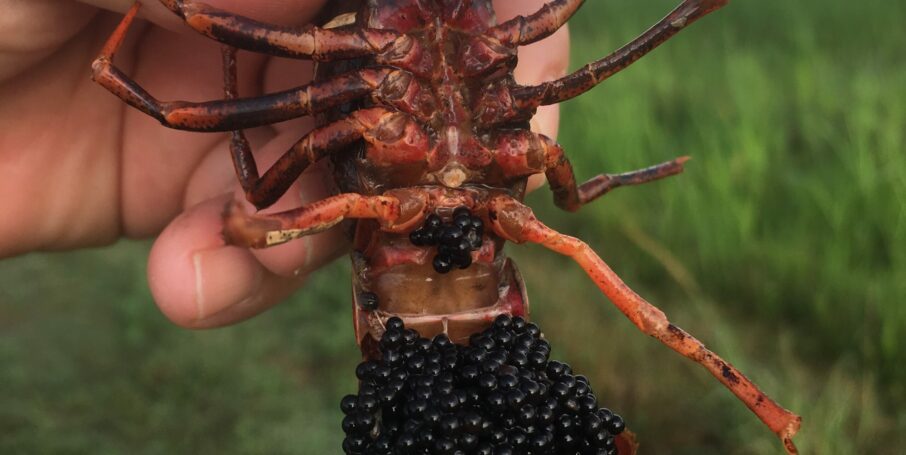LSU Ag Center Newsletter dated June 8, 2021
The success or failure of next year’s crawfish crop depends on the survival of the brood stock over the summer. Permanent ponds usually do not need any additional stock added to the pond, since a sufficient number of crawfish are still present in the pond at the end of the season. New ponds such as rice fields will need to be stocked to develop a population of crawfish next year.
The optimal time to stock crawfish is in May and June. It is still possible to stock ponds later but there are some concerns. Good, healthy, mature crawfish might still be available from the Atchafalaya Basin in July, but the price will be higher and they may be a little delayed in their spawning cycle. Mature female crawfish that mated and went into a burrow in May will spawn earlier in the fall than the crawfish that are stocked into a pond in July.
Usually, the peak of spawning (egg laying and hatching) occurs in October. That will give the young crawfish time to grow rapidly before the water gets cold in winter. Young crawfish that hatch in December and January will grow slowly for the first few months due to the cold water. They will not reach harvest size until much later in the season.
Besides the time of stocking, the amount to stock (pounds per acre) is a key factor. How many female crawfish need to spawn to produce enough crawfish for a good crop? Let’s do some math.
To harvest a crop of 800 pounds per acre during the season and figuring 18 crawfish per pound, that translates into 14,400 crawfish that must survive long enough during the season to get into the traps. A female Red Swamp Crawfish can produce 200 to 500 eggs when she spawns, depending on the size of the crawfish. So, if we use 300 as an average spawn, the offspring of only 48 female crawfish would yield 800 pounds per acre – if they all survived. Forty-eight crawfish is only 2.7 pounds of mature females per acre.
So why do we stock 60 to 90 pounds per acre? The sex ratio and the survival/mortality rates are the reasons to stock more than just 2.7 pounds of mature female crawfish per acre. At least half of the brood stock a farmer puts into a pond are males and sometimes it can be 60% or even 70% males by June. Additionally, some percentage of the female crawfish will not be mature.
By far though, it is the survival/mortality rate that influences the total amount of stock to put into a new pond.
The general health of the brood stock at the start can have a bearing on survival. If the crawfish are coming out of good water quality and have plenty of food, the fat in the head should have a bright yellow color. Crawfish with a pale or brown colored fat are less healthy and may not survive until October to spawn.
When purchasing stock, the length of time out of water and how they are handled can affect survival. The longer this aquatic animal is out of water, exposed to heat, sunshine and wind as well as being crushed in a sack will increase the mortality. Some of the crawfish will still be alive when the sack is dumped into the pond, but they may die within a few days due to injuries or their gills were damaged during the transfer ordeal.
Move the crawfish from the source to the pond to be stocked as fast as possible. Stocking during cloudy or rainy weather can help reduce stress. Do not use crawfish that were stored in a cooler overnight. Also examine every sack to be sure that no White River Crawfish get into the pond.
Now consider all the other natural mortality factors that come into play as soon as the crawfish get into the new pond. High water temperature, natural predators such as birds, snakes, frogs, mink, etc., and a host of parasites can affect their gills and other organs. If natural mortality is high during the summer, next year’s crop could be quite low or even a complete failure.
Floods or droughts during the summer can be a problem. Summer floods can force the crawfish to emerge from burrows in August or September only to be subjected to high temperatures and stagnant water with no oxygen. Unless they can find their old burrow or dig a new one, they will die. Drought can cause the ground to crack and dry up the water in the burrow. Without moisture in the burrow, the crawfish will die.
The only indication that some of the mature female crawfish are present in the pond are the burrows that may or may not be evident along the edge of the water. Look for burrows at the waterline along the levees. While the exact number of burrows has not been correlated to potential yields, some burrows should be observed every few feet. One burrow along 100 feet of levee would suggest that not enough crawfish are present to sufficiently populate the pond next year.
More than 40 burrows per 100 feet suggests the pond may be overpopulated and result small, stunted crawfish. This is what happens in some permanent ponds after two or three seasons. Adding stock only makes the stunting problem worse.
Farmers can find guidance on stocking in the Crawfish Production Manual available on-line at: lsuagcenter.com. This reference guide also has pictures of egg development that indicates the maturity of female crawfish.

